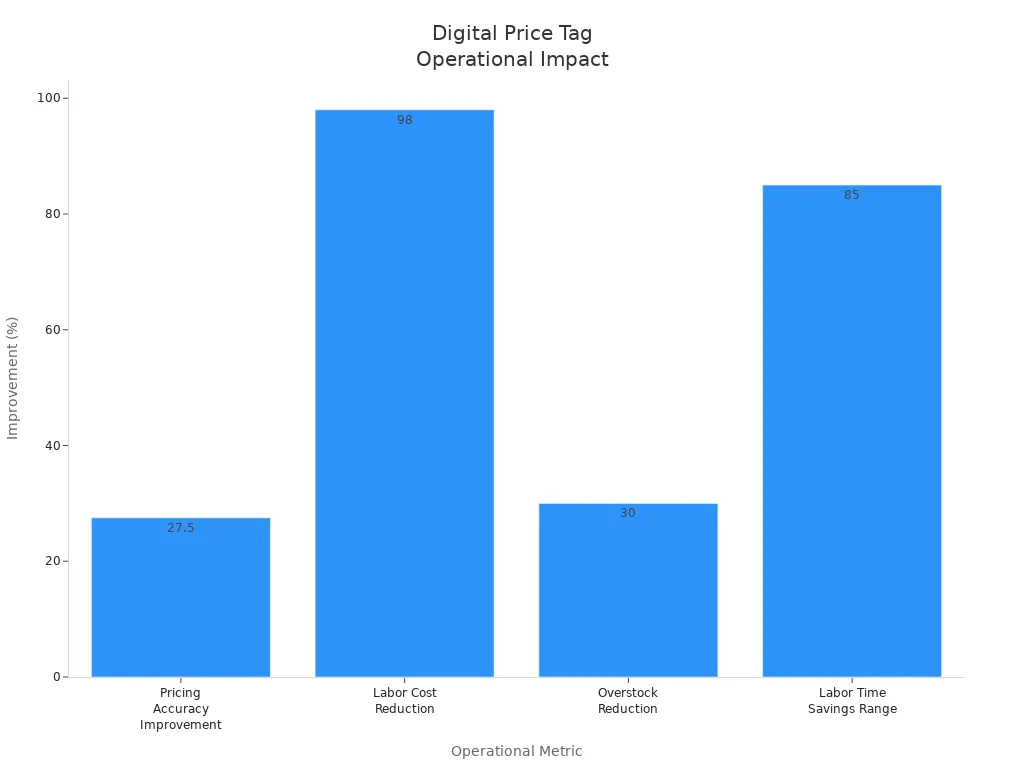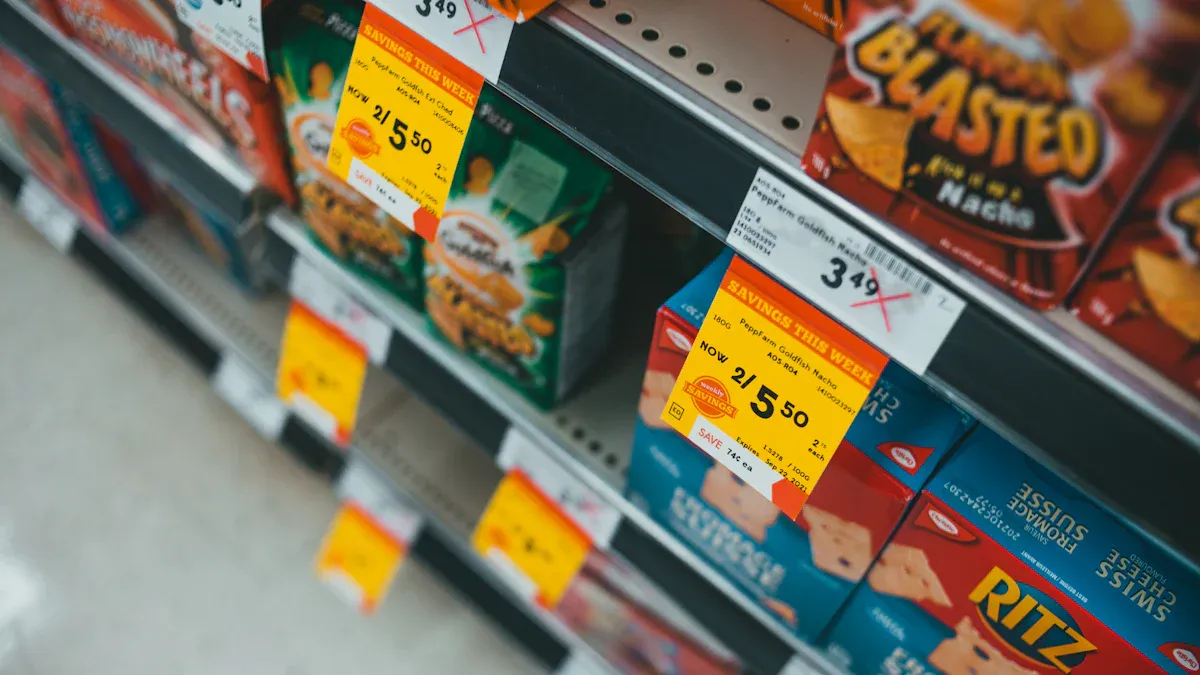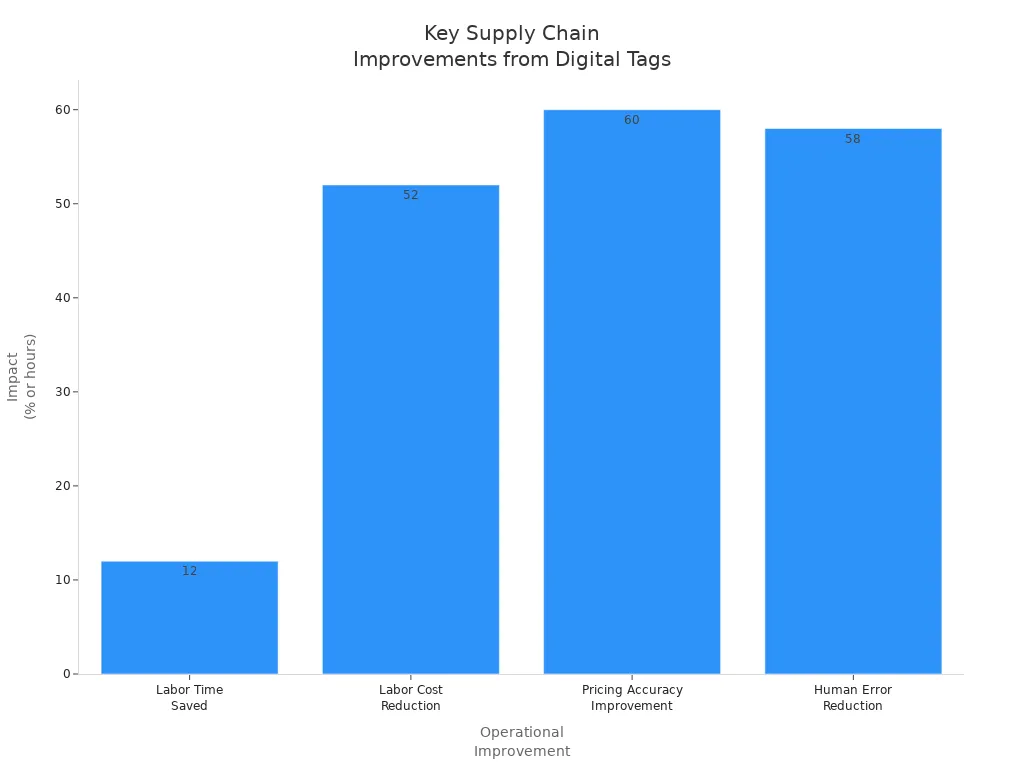
Retailers worldwide continue to embrace digital price tags for sharper inventory control and operational agility. These solutions, including Electronic Shelf Labels and ESL Gateway AP, synchronize instantly with inventory management systems, enabling just-in-time inventory by providing real-time updates. Automated price and stock adjustments through ESL Price Tag and Esl Retail platforms help prevent overstock and stockouts.
- North America and Western Europe lead adoption, while Asia-Pacific shows rapid growth.
- Large retail chains drive market expansion, supported by government digitalization efforts.
- Key benefits include operational efficiency, enhanced customer experience, and data-driven strategies.

| Metric / Example | Details |
|---|---|
| Pricing Accuracy Improvement | Up to 25-30% reduction in pricing errors compared to traditional methods |
| Labor Cost Reduction | Up to 98% reduction in labor costs for price updates |
| Overstock Reduction | Up to 30% reduction in unsalable inventory through dynamic pricing and automated markdowns |
| Stockout Prevention | Real-time alerts for low stock enable immediate replenishment, preventing stockouts |
Digital Price Tags and Real-Time Inventory Management

What Sets Digital Price Tags Apart
Key Features and Capabilities
Digital price tags introduce a new era of efficiency for retailers. These devices offer instant, wireless updates that eliminate the need for manual price changes. Retailers can manage thousands of tags from a single cloud-based platform, ensuring consistency across all shelves. E-paper technology powers these tags, providing clear displays and battery life that can last up to five years. Advanced models support dynamic content, such as QR codes and real-time promotions, which enhance customer engagement. Security protocols protect sensitive pricing and inventory data, while automation reduces human error and operational costs.
Tip: Retailers using digital price tags often see improved pricing accuracy and faster inventory turnover, which builds customer trust and loyalty.
Differences from Traditional Price Tags
The contrast between traditional and digital price tags becomes clear when examining their core features:
| Feature | Traditional Price Tags | Digital Price Tags (ESLs) |
|---|---|---|
| Update Speed | Manual, slow price changes | Instant, wireless updates |
| Error Rate | High, prone to manual errors | Low, automated updates reduce errors |
| Content Dynamics | Static information only | Dynamic content including QR codes and promotions |
| Integration | None or limited | Integrated with POS and inventory systems for real-time sync |
| Power Consumption | N/A (paper tags) | Low power e-paper technology with battery life up to 5 years |
| Management | Manual, decentralized | Cloud-based centralized management |
| Pricing Flexibility | Fixed prices | Supports dynamic pricing and AI-driven adjustments |
| Customer Engagement | Basic, static | Interactive features enhancing shopping experience |
| Labor and Cost Impact | High labor for updates, risk of errors | Automation reduces manual labor and errors, cuts paper waste |
| Security | N/A | Secure wireless communication and data protection |
Digital price tags stand out by enabling real-time synchronization with inventory management systems. This integration supports dynamic pricing strategies and reduces the risk of manual errors.
Integration with Inventory Management Systems
Real-Time Data Synchronization
Retailers benefit from seamless integration between digital price tags and inventory management systems. Leading technology providers, such as SES-imagotag and Zebra Technologies, offer platforms that connect electronic shelf labels directly to inventory databases. This connection allows for real-time updates on stock levels and pricing. Cloud-based solutions further enhance this process by enabling remote management and instant data analytics. As a result, retailers gain accurate visibility into inventory, which supports better decision-making and operational efficiency.
Automated Price and Stock Updates
Automated updates represent a major advantage of digital price tags. When inventory management systems detect changes in stock or pricing, the system pushes updates instantly to every relevant tag. This automation eliminates the need for manual label changes and reduces the risk of pricing errors. Retailers can also implement dynamic pricing strategies, adjusting prices based on demand, time of day, or promotional campaigns. The integration of digital price tags with inventory management systems streamlines operations and supports just-in-time inventory practices.
Real-Time Inventory Visibility for Just-in-Time Inventory
Instant Stock Level Updates with Digital Price Tags
Automatic Inventory Adjustments
Digital price tags connect directly to a store’s central inventory system, displaying the most current inventory levels on the shelf. When stock drops below a set threshold, the system sends instant reminders to staff. Employees can then replenish items quickly, often within minutes, which keeps shelves full and customers satisfied. This real-time inventory visibility supports just-in-time inventory by improving accuracy and responsiveness. Retailers avoid both empty shelves and unnecessary inventory backlogs, which strengthens overall inventory control.
- Electronic price tags display up-to-date inventory status.
- Staff receive low-stock alerts, enabling fast replenishment.
- Real-time visibility saves time and supports quick responses to demand changes.
- Clear inventory data helps prevent overstock and stockouts.
Retailers using these systems report measurable improvements in stock level update speed. For example, when a high-priority product runs low, staff receive immediate notifications and can restock from the backroom in under five minutes. This rapid response reduces delays and ensures products remain available for customers.
Reducing Manual Stock Checks
Automated inventory tracking with digital price tags reduces the need for manual stock checks. Staff no longer spend hours scanning shelves or counting products. Instead, the system provides continuous updates on inventory levels, allowing employees to focus on higher-value tasks. This automation helps prevent out-of-stock situations and lowers holding costs by keeping inventory closely aligned with actual demand. The result is a more efficient workflow and improved just in time inventory practices.
Data-Driven Decision Making in Just-in-Time Inventory
Predictive Replenishment
Data-driven inventory management uses analytics from both historical and real-time data to optimize inventory levels and replenishment strategies. AI-powered algorithms analyze sales trends and customer behavior, generating accurate demand forecasts. This approach enhances demand planning and reduces carrying costs by aligning inventory with real demand. Manufacturers and distributors benefit from fewer production delays and improved supply chain efficiency, which supports just-in-time inventory by minimizing waste and ensuring timely product availability.
A study from Auburn University found that retailers using real-time monitoring technologies achieved inventory accuracy rates between 95% and 99%. This high level of accuracy allows digital price tags to provide precise shelf monitoring and dynamic pricing. AI and machine learning use this data to forecast demand, optimize reorder points, and adjust inventory levels, reducing both overstock and stockouts.
Dynamic Pricing and Promotions
Digital price tags enable retailers to implement dynamic pricing and targeted promotions based on real-time inventory data. When inventory levels fluctuate, the system can automatically adjust prices or trigger special offers to balance supply and demand. Integration with IoT and analytics tools allows retailers to analyze customer behavior and sales patterns, supporting strategic decisions that improve just in time inventory outcomes. This combination of technology and data ensures that inventory remains at optimal levels, reducing excess stock and improving customer satisfaction.
Achieving Just-in-Time Inventory with Digital Price Tags
Aligning Stock with Demand for Just-in-Time Delivery
Minimizing Overstock and Stockouts
Retailers strive to maintain optimal inventory levels, avoiding both excess stock and empty shelves. Digital price tags play a pivotal role in this process by enabling real-time synchronization between shelf displays and inventory management systems. When a product’s stock drops below a predefined threshold, the system triggers immediate alerts, prompting timely replenishment. This automation reduces the risk of overstock and stockouts, which are common challenges in just-in-time inventory environments.
The following table highlights the measurable impact of digital price tags on inventory accuracy and operational efficiency:
| Impact Area | Statistical Evidence |
|---|---|
| Pricing Accuracy | Up to 60% increase in pricing accuracy after adopting digital price tags |
| Human Error Reduction | 58% reduction in human error related to pricing and inventory marking automation |
| Labor Time Saved | Up to 12 hours saved per week per store by automating price updates |
| Labor Cost Reduction | Approximately 52% reduction in labor costs related to price updates |
| Label Maintenance | 80% reduction in label maintenance time (e.g., Carrefour) |
| Pricing Errors | 50% fewer pricing errors (e.g., Carrefour) |
Retailers such as Carrefour, Tesco, and JD.com have reported significant improvements after implementing digital price tags. Carrefour achieved an 80% reduction in label maintenance time and 50% fewer pricing errors. Tesco benefits from synchronized price updates across multiple locations, which streamlines pricing efficiency and productivity. JD.com leverages AI-powered dynamic pricing and shelf management, optimizing prices and in-store efficiency to match online standards. These operational gains enable timely inventory adjustments, directly reducing overstock and stockouts in just-in-time inventory management.
Note: Real-time price updates and inventory synchronization support markdown strategies for near-expiry products, helping retailers move inventory quickly and reduce waste.
- Real-time price updates allow immediate response to market changes and supply fluctuations.
- Synchronization of shelf and checkout prices improves accuracy and shopper trust.
- Markdown strategies for near-expiry products help move inventory quickly, reducing waste.
- Integration with inventory systems provides alerts for low stock, preventing stockouts.
- Dynamic discounting (such as dairy products with QR code shelf-life pricing) increases sales and reduces spoilage.
Faster Response to Market Changes
Market conditions can shift rapidly due to factors like supply chain disruptions, seasonal demand, or competitor actions. Digital price tags empower retailers to respond instantly to these changes. Automated price adjustments occur within seconds, ensuring that pricing remains competitive and inventory levels stay balanced. For example, a UK grocery store increased its price changes by 54% after adopting electronic shelf labels, while a European retailer saw an 853% increase in price changes using ESLs with expanded barcodes.
- Digital price tags enable rapid price adjustments, allowing stores to respond immediately to supply chain disruptions and demand changes.
- Integration with inventory and POS systems allows automatic price updates triggered by inventory changes, such as markdowns for near-expiration products.
- Cloud-based centralized management synchronizes pricing across multiple locations, enhancing responsiveness.
- AI-driven dynamic pricing models enable real-time price adjustments responding to customer behavior and market data, improving operational efficiency and reducing manual labor.
- ESLs reduce stockouts by communicating product availability and integrating with QR codes for online ordering of out-of-stock items.
Retailers like Carrefour have implemented ESLs to efficiently manage thousands of weekly price changes, reducing labor costs and improving pricing accuracy. Real-time dynamic pricing based on accurate inventory data reduces food waste and improves inventory accuracy, supporting just-in-time delivery and agile inventory management.
Streamlining Supply Chain Operations
Improved Supplier Coordination
Digital price tags enhance communication between retailers and suppliers by providing accurate, real-time inventory data. Suppliers receive timely updates on stock levels, enabling them to adjust shipments and production schedules to match actual demand. This level of transparency supports just-in-time inventory by minimizing excess stock and ensuring products arrive precisely when needed. Improved coordination reduces the risk of supply chain bottlenecks and enhances overall supply chain management.
Shorter Lead Times
Automated price and inventory updates accelerate the entire replenishment process. When inventory levels reach a critical point, the system notifies both store staff and suppliers, triggering immediate restocking actions. This automation shortens lead times and ensures that products move efficiently from supplier to shelf. The following chart illustrates the operational improvements observed after implementing digital price tags:

Digital price tags significantly improve supply chain efficiency by automating the labor-intensive and error-prone manual price update process. This automation reduces labor costs and frees staff to focus on customer service and other value-added activities, thereby increasing productivity. Real-time, centralized price updates across multiple locations accelerate price changes from hours or days to seconds, enhancing store responsiveness to market dynamics. Additionally, digital price tags support dynamic pricing strategies that optimize revenue and minimize waste, contributing to overall operational gains and omnichannel pricing consistency critical for modern retail supply chains.
Tip: Automated inventory management and real-time supplier communication help retailers achieve just-in-time delivery, reduce lead times, and maintain optimal stock levels.
Operational Benefits of Digital Price Tags in Inventory Management
Error Reduction and Inventory Accuracy
Eliminating Pricing Mistakes
Digital price tags transform the way retailers manage pricing on the sales floor. These electronic labels enable real-time price updates, which ensure that shelf prices always match checkout prices. This consistency reduces pricing errors and minimizes customer disputes. Automated synchronization with inventory management systems allows instant updates, eliminating the need for manual price changes. Retailers such as Walmart and Whole Foods have adopted digital price tags and reported measurable improvements, including fewer pricing errors and reduced inventory shrinkage.
- Real-time price updates maintain consistency between shelf and checkout.
- Automated alerts for low stock prevent out-of-stock situations.
- Dynamic pricing and automated reordering help reduce waste and improve product availability.
A European supermarket chain experienced a 60% increase in pricing accuracy and a 40% reduction in pricing errors after implementing digital price tags. These improvements support stronger inventory control and build customer trust.
Enhancing Inventory Record Precision
Digital price tags connect directly to inventory management systems, providing instant stock updates. This automation improves inventory accuracy from approximately 65% with manual methods to over 98% with digital solutions. Staff receive automated alerts for low stock, which enables faster restocking and reduces the risk of overstocking. Case studies show that digital price tags improve execution accuracy to 99%, leading to operational efficiencies and better just-in-time inventory practices.
Labor and Cost Savings in Just-in-Time Inventory
Reducing Manual Label Changes
Retailers save significant labor time by automating price updates. Digital price tags eliminate the need for employees to manually change paper labels, freeing staff for higher-value tasks. For example, Naifeh’s Cash Saver reduced manual price tag changes from 50 hours per week to just three minutes for 2,000 tags. This dramatic time savings allows employees to focus on customer service and store operations, which supports higher profits.
| Retailer | Labor Savings Detail | Cost/ROI Details |
|---|---|---|
| Naifeh’s Cash Saver | Reduced manual price tag changes from 50 hours/week to 3 minutes for 2,000 tags | Investment cost approx. $100,000; ROI expected in less than 2 years |
| Maurer’s Market IGA | N/A | Investment cost $208,000; ROI expected in 1.5 to 2.5 years |
| Houchens Food Group | N/A | ROI expected in about 3.5 years |
Lowering Operational Costs
Electronic price tags drive cost reduction by automating price updates and promotions. This automation reduces the time and resources spent on manual pricing, minimizes human errors, and ensures pricing consistency. Retailers also benefit from reduced paper label usage, which lowers manufacturing and labor costs. Real-time price updates and automated inventory management optimize workflows and enable dynamic pricing adjustments. These operational efficiencies contribute to higher profits and a stronger return on investment.
| Operational Cost Reduction Aspect | Explanation |
|---|---|
| Labor Savings | Eliminates manual price tag changes, saving significant employee time and reducing errors. |
| Paper Label Usage Reduction | Decreases the need for paper labels, lowering manufacturing and labor costs. |
| Real-time Price Updates | Enables instant price changes, improving efficiency and reducing time spent on pricing tasks. |
| Automated Inventory Management | Supports inventory tracking and management, optimizing operational workflows. |
| Dynamic Pricing Adjustments | Allows flexible pricing strategies that can adapt quickly to market conditions. |
Note: Digital price tags help retailers achieve just-in-time inventory by streamlining operations, reducing errors, and supporting cost-effective inventory management.
Enhancing Customer Experience with Digital Price Tags

Accurate and Up-to-Date Pricing for Just-in-Time Inventory
Building Customer Trust
Digital price tags deliver real-time, accurate pricing directly to the shelf. These tags connect wirelessly to a central system, allowing retailers to update prices instantly across all locations. Customers see the same price on the shelf as at checkout, which builds trust and reduces confusion. The automation of price updates removes manual errors, so shoppers can rely on the information displayed.
- Prices update instantly, reflecting current inventory and market conditions.
- Customers always see accurate, consistent pricing, which helps them make informed decisions.
- Automated updates eliminate the risk of outdated or incorrect prices.
Customers appreciate a transparent shopping environment. When they see clear, up-to-date prices, their confidence in the retailer grows.
Supporting Omnichannel Consistency
Retailers use digital price tags to synchronize pricing and inventory information across physical and online stores. Centralized management software enables real-time updates, ensuring that promotions and stock levels remain consistent on every channel. This approach supports a seamless omnichannel experience, where customers can trust that the price and availability they see online matches what they find in-store.
- Digital price tags automate price and inventory updates, reducing labor costs and errors.
- Centralized systems allow retailers to manage prices and stock across multiple locations and platforms.
- Features like NFC and QR codes on electronic shelf labels let customers interact with products, check availability, and even add items to online baskets.
A large retailer reported a measurable increase in employee productivity and customer satisfaction after adopting electronic shelf labels. Customers benefit from a unified experience, whether shopping in person or online.
Improved Product Availability and Just-in-Time Delivery
Reducing Out-of-Stock Frustrations
Digital price tags play a crucial role in just in time inventory management by providing real-time stock visibility. When inventory levels change, the system updates both the shelf label and the central database immediately. Staff receive alerts for low stock, enabling quick replenishment and reducing the chance of empty shelves.
- Real-time updates prevent out-of-stock situations and keep shelves full.
- Customers spend less time searching for products, improving their overall experience.
- Automated alerts help staff respond quickly to inventory changes.
Enabling Personalized Offers
Retailers can use digital price tags to deliver targeted promotions based on inventory data and customer behavior. Dynamic pricing and real-time promotions encourage shoppers to take advantage of special offers, especially when stock levels are high or products near expiration. This flexibility supports just in time inventory strategies by moving products efficiently and reducing waste.
- Digital tags display personalized offers and promotions instantly.
- Customers receive relevant deals, increasing satisfaction and loyalty.
- Retailers optimize inventory turnover and minimize excess stock.
Tip: Digital price tags bridge the gap between physical and digital retail, creating a more engaging and responsive shopping experience.
Empowering Employee Workflows in Just-in-Time Inventory Management
Simplifying Store Operations with Digital Price Tags
Streamlined Restocking Processes
Digital price tags transform daily store operations by automating many manual tasks. Employees no longer spend hours updating paper labels or checking shelves for pricing accuracy. Instead, centralized control systems push instant updates to every shelf, ensuring that information remains current. This automation allows staff to focus on higher-value activities, such as restocking and customer service.
The following table highlights key operational benefits:
| Benefit Aspect | Evidence Supporting Operational Efficiency |
|---|---|
| Labor Time Saved | Automation of price updates saves up to 12 hours per week per store. |
| Labor Cost Reduction | Labor costs related to price updates reduced by approximately 52%. |
| Pricing Accuracy | Pricing accuracy improved by 60%, reducing pricing errors significantly. |
| Error Reduction | Automation reduces human error in pricing and inventory marking by 58%. |
| Cost Savings | Printing and material costs (paper, ink, adhesives) are significantly lowered. |
| Faster Price Changes | Centralized control enables instant price updates across multiple locations. |
| Staff Redeployment | Employees freed from manual pricing tasks can focus on customer service. |
| Audit Trail | Every price change is logged, enhancing transparency and accountability. |
Over 68% of large retail chains have adopted digital price tags. Retailers such as Monoprix and Westside Market NYC report faster new product rollouts and improved pricing accuracy. These improvements support just-in-time inventory by keeping inventory levels aligned with real-time demand.
Easier Price Adjustments
Digital price tags enable instant price changes across all shelves. Managers can update prices for thousands of products with a single command. This capability reduces the risk of pricing errors and ensures that promotions or markdowns take effect immediately. Employees no longer need to walk the aisles to replace tags, which saves time and reduces fatigue. The audit trail feature logs every change, supporting accountability and compliance.
Enabling Proactive Inventory Management
Real-Time Alerts for Low Stock
Digital price tags connect directly to inventory management systems, providing real-time alerts when stock runs low. Staff receive notifications on handheld devices or store dashboards, allowing them to restock shelves quickly. This proactive approach minimizes out-of-stock situations and keeps products available for customers. Automated alerts also help reduce stock discrepancies and support accurate inventory tracking.
- Labor cost savings of up to 90% due to automation reducing manual price updates and inventory checks.
- Pricing accuracy improvements ranging from 25% to 60%, leading to fewer pricing errors and increased customer trust.
- Reduction in human errors by up to 58%, minimizing mistakes in pricing and inventory management.
- Inventory tracking accuracy reaching up to 99% with RFID integration, enhancing real-time visibility.
- Faster restocking and fewer stock discrepancies enabled by real-time tracking and automated alerts.
Supporting Staff Training and Efficiency
Digital price tags simplify training for new employees. Staff learn to manage price updates and inventory checks through intuitive digital interfaces rather than manual processes. This technology reduces onboarding time and helps employees become productive faster. Dynamic pricing capabilities allow instant adjustments based on demand or product lifecycle, improving product turnover by approximately 15%. Sustainability benefits also arise from reduced paper waste and energy consumption, as stores replace paper tags with energy-efficient electronic shelf labels.
Tip: Enhanced demand forecasting and inventory planning, supported by IoT connectivity and AI-driven analytics, enable proactive inventory management and stock optimization.
Real-World Examples and Measurable Outcomes of Digital Price Tags
Case Studies from Retailers Using Just-in-Time Inventory
Quantifiable Improvements in Inventory Turnover
Retailers who have adopted digital price tags report significant gains in operational efficiency and inventory strategies. The following outcomes highlight the measurable impact:
- Product turnover rates increase by 15% due to dynamic pricing capabilities.
- Pricing errors decrease by about 30%, which improves inventory accuracy.
- Stores save approximately three hours per week by reducing manual price tag updates.
- Restocking time drops by 35% with the help of label alerts and LED indicators.
- Order fulfillment time can be reduced by up to 50% through digital shelf label features.
- Supply chain lead times improve by an average of 10 days, which enhances stock availability.
These improvements allow retailers to align inventory strategies with real-time demand, resulting in better stock management and higher profits. Dynamic pricing and instant updates help stores move products efficiently, reducing excess inventory and minimizing lost sales opportunities.
Reduction in Labor Hours and Errors
Digital price tags automate many manual processes, leading to a notable reduction in labor hours and errors. Staff spend less time updating prices and more time on customer service or other value-added tasks. Automated alerts and real-time synchronization ensure that pricing remains accurate, which reduces the risk of costly mistakes. As a result, retailers experience fewer pricing disputes and improved customer satisfaction. The reduction in manual labor also contributes to increased profits, as operational costs decrease and staff productivity rises.
Lessons Learned and Best Practices for Digital Price Tags
Implementation Strategies
Retailers have identified several best practices for successful digital price tag implementation:
- Minimize price inconsistencies between online and physical stores to avoid customer confusion.
- Integrate digital price tags with existing POS and inventory systems for seamless operation.
- Provide comprehensive staff training and ongoing support to ensure accurate price updates.
- Use AI-powered audits and real-time compliance reporting to monitor for errors.
- Roll out the technology in phases and conduct pilot tests to adapt to technical or operational challenges.
- Respond quickly to customer feedback to build trust and enhance the shopping experience.
These strategies help retailers maximize the benefits of digital price tags while supporting effective inventory strategies.
Overcoming Common Obstacles
Retailers face several challenges during digital price tag adoption. Technical issues such as connectivity problems, hardware failures, and vendor lock-in require careful planning and vendor management. Ongoing system monitoring and regular staff training help maintain accuracy and reliability. Store size, layout, and staff readiness also influence the success of implementation. Clear communication about the technology and its benefits addresses skepticism and resistance among both staff and customers. Environmental benefits, such as reduced paper waste, align with sustainability goals and further support the business case for digital price tags.
Note: Early adopters report improved operational efficiency, pricing accuracy, and a competitive edge through dynamic pricing. These outcomes demonstrate the value of digital price tags in modern retail environments.
Challenges and Future Trends in Digital Price Tags and Just-in-Time Inventory for 2025
Addressing Implementation Barriers in Inventory Management
Integration with Legacy Systems
Retailers often encounter significant challenges when integrating digital price tags with existing inventory and point-of-sale systems. Many stores operate with legacy software that lacks compatibility with modern digital solutions. To overcome this, retailers use middleware platforms that bridge communication between digital price tags, inventory management, and POS systems. This approach prevents pricing errors and ensures seamless data flow. Retailers also select mounting methods—such as clip-on, magnetic, or rail systems—to fit existing store fixtures, which helps avoid expensive retrofitting. Hardware durability remains a priority, with many stores choosing rugged, water-resistant, or frost-proof labels to withstand demanding retail environments.
Managing Upfront Costs
The initial investment for digital price tags includes hardware, software, and installation expenses. Retailers must also consider ongoing maintenance and staff training. Some stores address these costs by selecting power solutions tailored to their needs, such as battery-powered, hardwired, or solar-powered tags, which optimize energy use and reduce long-term expenses. Cloud-based or hybrid server models allow centralized management, helping retailers synchronize data across multiple locations and streamline operations. Despite these strategies, dependence on technology infrastructure—like Wi-Fi and power—remains a concern, especially during outages. Environmental considerations, such as electronic waste and energy consumption, also influence purchasing decisions.
Note: Retailers who plan carefully and invest in robust infrastructure can minimize disruptions and maximize the value of digital price tags.
Innovations Shaping the Future of Just-in-Time Inventory
AI-Driven Inventory Optimization
Artificial intelligence is transforming inventory management. AI-powered dynamic pricing adjusts prices in real time based on market data and stock levels, allowing retailers to respond quickly to changes in demand. Predictive analytics use machine learning to forecast demand with high accuracy, improving inventory ordering and reducing waste. Hyper-personalization, driven by AI, tailors stock to customer preferences and buying behavior. Integration with enterprise resource planning (ERP) systems enables real-time stock monitoring and automated replenishment, ensuring shelves remain stocked without excess inventory.
Expanding IoT Connectivity
The evolution of digital price tags relies heavily on expanding IoT connectivity. IoT-enabled shelves and RFID technology provide real-time inventory tracking and instant notifications when stock runs low. Digital price tags act as data nodes, facilitating dynamic pricing updates and automating inventory tasks. This connectivity improves operational efficiency and reduces manual errors. IoT sensors, such as weight-based systems, enable no-touch inventory tracking and automatic reorder initiation. Advances in 5G and cloud computing further enhance scalability and functionality, supporting precise, real-time monitoring across the supply chain. As a result, retailers gain better decision-making tools, improved demand forecasting, and synchronized supply chain activities.
Tip: Retailers who embrace AI and IoT innovations position themselves for greater agility and efficiency in just-in-time inventory management.
Digital price tags transform inventory management by automating price updates, reducing manual errors, and enabling dynamic pricing. Retailers benefit from real-time stock alerts, streamlined operations, and lower labor costs. Employees focus on customer service and efficient restocking. Shoppers enjoy accurate pricing, instant promotions, and interactive product information.
- Automates price updates and inventory sync
- Frees staff for higher-value tasks
- Delivers real-time, accurate pricing for customers
- Supports sustainability by reducing paper and food waste
Retailers who adopt digital price tags position their stores for agile, future-ready inventory management and just-in-time delivery.
FAQ
What are digital price tags?
Digital price tags, also called electronic shelf labels (ESLs), display product prices and information electronically. Retailers update them remotely using a central system. These tags replace paper labels and support real-time pricing and inventory management.
How do digital price tags improve inventory accuracy?
Digital price tags connect directly to inventory management systems. They update stock levels and prices instantly. This automation reduces manual errors and ensures that shelf information matches actual inventory data.
Can digital price tags integrate with existing POS systems?
Most digital price tag solutions offer integration with modern POS and inventory systems. Retailers use middleware or APIs to connect digital tags with legacy software, enabling seamless data synchronization and real-time updates.
What is the typical ROI for digital price tag implementation?
Retailers often see a return on investment within two to three years. Savings come from reduced labor costs, fewer pricing errors, and improved inventory turnover. The exact ROI depends on store size, product range, and operational complexity.
Are digital price tags secure?
Digital price tags use encrypted wireless communication. Security protocols protect pricing and inventory data from unauthorized access. Retailers should follow best practices for network security and device management.
How do digital price tags support just-in-time inventory?
Digital price tags provide real-time stock visibility and instant alerts for low inventory. This supports timely replenishment and reduces overstock or stockouts. Retailers align inventory levels closely with actual demand.
What maintenance do digital price tags require?
Digital price tags need minimal maintenance. Most use e-paper displays with batteries lasting several years. Retailers occasionally replace batteries or update firmware. Centralized management software simplifies monitoring and troubleshooting.
Can digital price tags display promotions or QR codes?
Many digital price tags support dynamic content, including promotions, barcodes, and QR codes. Retailers use these features to engage customers, provide product details, or enable mobile interactions.


